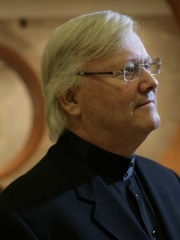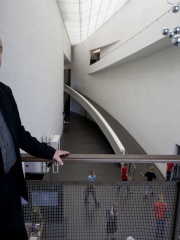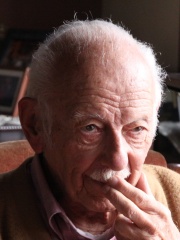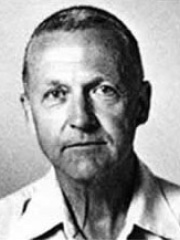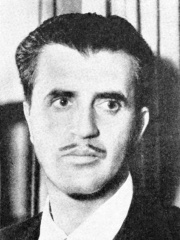
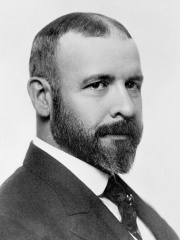
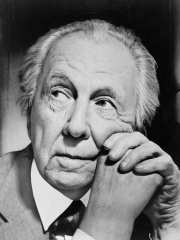
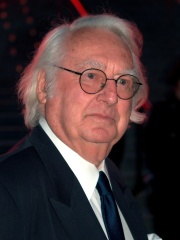
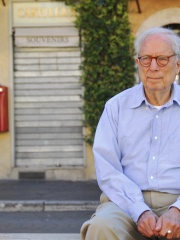
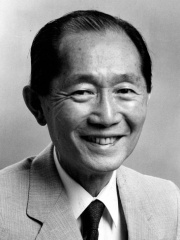
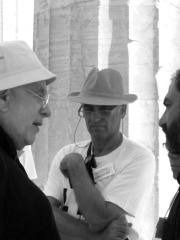
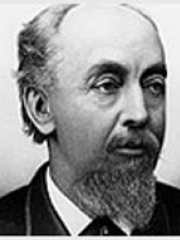
The Most Famous
ARCHITECTS from United States
This page contains a list of the greatest American Architects. The pantheon dataset contains 518 Architects, 40 of which were born in United States. This makes United States the birth place of the 5th most number of Architects behind United Kingdom, and France.
Top 10
The following people are considered by Pantheon to be the top 10 most legendary American Architects of all time. This list of famous American Architects is sorted by HPI (Historical Popularity Index), a metric that aggregates information on a biography's online popularity. Visit the rankings page to view the entire list of American Architects.

1. Buckminster Fuller (1895 - 1983)
With an HPI of 78.87, Buckminster Fuller is the most famous American Architect. His biography has been translated into 70 different languages on wikipedia.
Richard Buckminster Fuller Jr. (; July 12, 1895 – July 1, 1983) was an American architect, systems theorist, writer, designer, inventor, philosopher, and futurist. He styled his name as R. Buckminster Fuller in his writings, publishing more than 30 books and coining or popularizing such terms as "Spaceship Earth", "Dymaxion" (e.g., Dymaxion house, Dymaxion car, Dymaxion map), "ephemeralization", "synergetics", and "tensegrity". Fuller developed numerous inventions, mainly architectural designs, and popularized the widely known geodesic dome; carbon molecules known as fullerenes were later named by scientists for their structural and mathematical resemblance to geodesic spheres. He also served as the second World President of Mensa International from 1974 to 1983. Fuller was awarded 28 United States patents and many honorary doctorates. In 1960, he was awarded the Frank P. Brown Medal from the Franklin Institute. He was elected an honorary member of Phi Beta Kappa in 1967, on the occasion of the 50-year reunion of his Harvard class of 1917 (from which he had been expelled in his first year). He was elected a Fellow of the American Academy of Arts and Sciences in 1968. The same year, he was elected into the National Academy of Design as an Associate member. He became a full Academician in 1970, and he received the Gold Medal award from the American Institute of Architects the same year. Also in 1970, Fuller received the title of Master Architect from Alpha Rho Chi (APX), the national fraternity for architecture and the allied arts. In 1976, he received the St. Louis Literary Award from the Saint Louis University Library Associates. In 1977, he received the Golden Plate Award of the American Academy of Achievement. He also received numerous other awards, including the Presidential Medal of Freedom, presented to him on February 23, 1983, by President Ronald Reagan.

2. Louis Sullivan (1856 - 1924)
With an HPI of 78.87, Louis Sullivan is the 2nd most famous American Architect. His biography has been translated into 54 different languages.
Louis Henry Sullivan (September 3, 1856 – April 14, 1924) was an American architect, and has been called a "father of skyscrapers" and "father of modernism". He was an influential architect of the Chicago School, a mentor to Frank Lloyd Wright, and an inspiration to the Chicago group of architects who have come to be known as the Prairie School. Along with Wright and Henry Hobson Richardson, Sullivan is one of "the recognized trinity of American architecture." The phrase "form follows function" is attributed to him; it encapsulated earlier theories of architecture and he applied them to the modern age of the skyscraper. In 1944, Sullivan was the second architect to posthumously receive the AIA Gold Medal.

3. Frank Lloyd Wright (1867 - 1959)
With an HPI of 77.46, Frank Lloyd Wright is the 3rd most famous American Architect. His biography has been translated into 151 different languages.
Frank Lloyd Wright Sr. (June 8, 1867 – April 9, 1959) was an American architect, designer, writer, and educator. He designed more than 1,000 structures over a creative period of 70 years. Wright played a key role in the architectural movements of the twentieth century, influencing architects worldwide through his works and mentoring hundreds of apprentices in his Taliesin Fellowship. Wright believed in designing in harmony with humanity and the environment, a philosophy he called organic architecture. This philosophy was exemplified in Fallingwater (1935), which has been called "the best all-time work of American architecture". Wright was a pioneer of what came to be called the Prairie School movement of architecture and also developed the concept of the Usonian home within Broadacre City, his vision for urban planning in the United States. Wright also designed original and innovative offices, churches, schools, skyscrapers, hotels, museums, and other commercial projects. Wright-designed interior elements (including leaded glass windows, floors, furniture and even tableware) were integrated into these structures. He wrote several books and numerous articles and was a popular lecturer in the United States and in Europe. Wright was recognized in 1991 by the American Institute of Architects as "the greatest American architect of all time". In 2019, a selection of his work became a listed World Heritage Site under the name The 20th-Century Architecture of Frank Lloyd Wright. Raised in rural Wisconsin, Wright studied civil engineering at the University of Wisconsin and later apprenticed in Chicago, first briefly with Joseph Lyman Silsbee, and then with Louis Sullivan at Adler & Sullivan. Wright opened his own successful Chicago practice in 1893 and established a studio in his Oak Park, Illinois home in 1898. His fame increased, and his personal life sometimes made headlines: leaving his first wife Catherine "Kitty" Tobin for Mamah Cheney in 1909; the murder of Mamah, her children, and others at his Taliesin estate by a staff member in 1914; his tempestuous marriage with second wife Miriam Noel (m. 1923–1927); and his courtship and marriage to Olgivanna Lazović (m. 1928–1959).

4. Richard Meier (b. 1934)
With an HPI of 70.87, Richard Meier is the 4th most famous American Architect. His biography has been translated into 50 different languages.
Richard Meier (born October 12, 1934) is an American abstract artist and architect, whose geometric designs make prominent use of the color white. A winner of the Pritzker Architecture Prize in 1984, Meier has designed several iconic buildings including the Barcelona Museum of Contemporary Art, the Getty Center in Los Angeles, the High Museum of Art in Atlanta, and San Jose City Hall. In 2018, some of Meier's employees accused him of sexual assault, which led to him resigning from his firm in 2021.
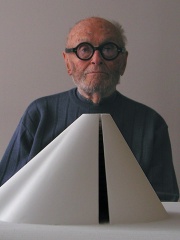
5. Philip Johnson (1906 - 2005)
With an HPI of 69.40, Philip Johnson is the 5th most famous American Architect. His biography has been translated into 59 different languages.
Philip Cortelyou Johnson (July 8, 1906 – January 25, 2005) was an American architect who designed modern and postmodern architecture. Among his best-known designs are his modernist Glass House in New Canaan, Connecticut; the postmodern 550 Madison Avenue in New York City, designed for AT&T; 190 South La Salle Street in Chicago; IDS Tower in downtown Minneapolis; the Sculpture Garden of New York City's Museum of Modern Art; and the Pre-Columbian Pavilion at Dumbarton Oaks. His January 2005 obituary in The New York Times described his works as being "widely considered among the architectural masterpieces of the 20th century". In 1930, Johnson became the first director of the architecture department of the Museum of Modern Art in New York. There he arranged for visits by Walter Gropius and Le Corbusier and negotiated the first American commission for Mies van der Rohe, after he fled Nazi Germany. In 1932, he organized with Henry-Russell Hitchcock the first exhibition dedicated to modern architecture at the Museum of Modern Art, which gave name to the subsequent movement known as International Style. In 1934, Johnson resigned his position at the museum. During the 1930s, Johnson became an ardent admirer of Adolf Hitler, openly praised the Nazi Party, and espoused antisemitic views. He wrote for Social Justice and Examiner, where he published an admiring review of Hitler's Mein Kampf. In 1939, as a correspondent for Social Justice, he witnessed Hitler's invasion of Poland, which he later described as "a stirring spectacle". In 1941, after the U.S. entered the war, Johnson abruptly renounced his earlier views, quit journalism, and organized an anti-Fascist league at Harvard Design School. He was investigated by the FBI, and was eventually cleared for military service. He evaded indictment and jail by cooperating with the prosecution, though, according to some critics, it may have been because of his social connections; no evidence of this was ever produced. Years later he would refer to these activities as "the stupidest thing I ever did [which] I never can atone for". In 1978, he was awarded an American Institute of Architects Gold Medal. In 1979, he was the first recipient of the Pritzker Architecture Prize. Today his skyscrapers are prominent features in the skylines of New York, Houston, Chicago, Detroit, Minneapolis, Pittsburgh, Atlanta, Madrid, and other cities.

6. Robert Venturi (1925 - 2018)
With an HPI of 69.07, Robert Venturi is the 6th most famous American Architect. His biography has been translated into 46 different languages.
Robert Charles Venturi Jr. (June 25, 1925 – September 18, 2018) was an American architect, founding principal of the firm Venturi, Scott Brown and Associates. Together with his wife and partner, Denise Scott Brown, he helped shape the way that architects, planners and students experience and think about architecture and the built environment. Their buildings, planning, theoretical writings, and teaching have also contributed to the expansion of discourse about architecture. Venturi was awarded the Pritzker Prize in Architecture in 1991; the prize was awarded to him alone, despite a request to include his equal partner, Scott Brown. Subsequently, a group of women architects attempted to get her name added retroactively to the prize, but the Pritzker Prize jury declined to do so. Venturi coined the maxim "Less is a bore", a postmodern antidote to Mies van der Rohe's famous modernist dictum "Less is more". Venturi lived in Philadelphia with Denise Scott Brown. He is the father of James Venturi, founder and principal of ReThink Studio.

7. Minoru Yamasaki (1912 - 1986)
With an HPI of 66.50, Minoru Yamasaki is the 7th most famous American Architect. His biography has been translated into 31 different languages.
Minoru Yamasaki (山崎 實, Yamasaki Minoru; December 1, 1912 – February 6, 1986) was an American architect, best known for designing the original World Trade Center in New York City and several other large-scale projects. He and fellow architect Edward Durell Stone are generally considered to be the two master practitioners of "New Formalism". During his three-decade career, he and his firm designed over 250 buildings. His firm, Yamasaki & Associates, closed on December 31, 2009.

8. Peter Eisenman (b. 1932)
With an HPI of 66.42, Peter Eisenman is the 8th most famous American Architect. His biography has been translated into 29 different languages.
Peter David Eisenman (born August 11, 1932) is an American architect. Considered one of the New York Five, Eisenman is known for his high modernist and deconstructive designs, as well as for his authorship of several architectural books. His work has won him several awards, including the Wolf Prize in Arts.

9. William Le Baron Jenney (1832 - 1907)
With an HPI of 65.31, William Le Baron Jenney is the 9th most famous American Architect. His biography has been translated into 34 different languages.
William Le Baron Jenney (September 25, 1832 – June 14, 1907) was an American architect and engineer known for building the first skyscraper in 1884. In 1998, Jenney was ranked number 89 in the book 1,000 Years, 1,000 People: Ranking the Men and Women Who Shaped the Millennium.
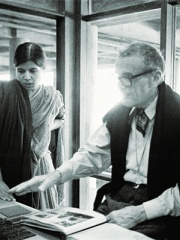
10. Charles Eames (1907 - 1978)
With an HPI of 62.86, Charles Eames is the 10th most famous American Architect. His biography has been translated into 18 different languages.
Charles Ormond Eames Jr. (June 17, 1907 – August 21, 1978) was an American designer, architect and filmmaker. In professional partnership with his wife Ray-Bernice Kaiser Eames, he made groundbreaking contributions in the fields of architecture, furniture design, industrial design, manufacturing and the photographic arts.
People
Pantheon has 40 people classified as American architects born between 1763 and 1986. Of these 40, 9 (22.50%) of them are still alive today. The most famous living American architects include Richard Meier, Peter Eisenman, and Nicholas Negroponte. The most famous deceased American architects include Buckminster Fuller, Louis Sullivan, and Frank Lloyd Wright. As of April 2024, 1 new American architects have been added to Pantheon including Jeanne Gang.
Living American Architects
Go to all RankingsRichard Meier
1934 - Present
HPI: 70.87
Peter Eisenman
1932 - Present
HPI: 66.42
Nicholas Negroponte
1943 - Present
HPI: 62.34
Adrian Smith
1944 - Present
HPI: 62.19
Steven Holl
1947 - Present
HPI: 60.54
Thom Mayne
1944 - Present
HPI: 60.34
Maya Lin
1959 - Present
HPI: 50.85
Jeanne Gang
1964 - Present
HPI: 41.37
Alexis Sablone
1986 - Present
HPI: 35.13
Deceased American Architects
Go to all RankingsBuckminster Fuller
1895 - 1983
HPI: 78.87
Louis Sullivan
1856 - 1924
HPI: 78.87
Frank Lloyd Wright
1867 - 1959
HPI: 77.46
Philip Johnson
1906 - 2005
HPI: 69.40
Robert Venturi
1925 - 2018
HPI: 69.07
Minoru Yamasaki
1912 - 1986
HPI: 66.50
William Le Baron Jenney
1832 - 1907
HPI: 65.31
Charles Eames
1907 - 1978
HPI: 62.86
Sixto Durán Ballén
1921 - 2016
HPI: 61.95
Gordon Bunshaft
1909 - 1990
HPI: 61.77
Kevin A. Lynch
1918 - 1984
HPI: 61.59
Cedric Gibbons
1893 - 1960
HPI: 60.67
Newly Added American Architects (2025)
Go to all RankingsOverlapping Lives
Which Architects were alive at the same time? This visualization shows the lifespans of the 25 most globally memorable Architects since 1700.


